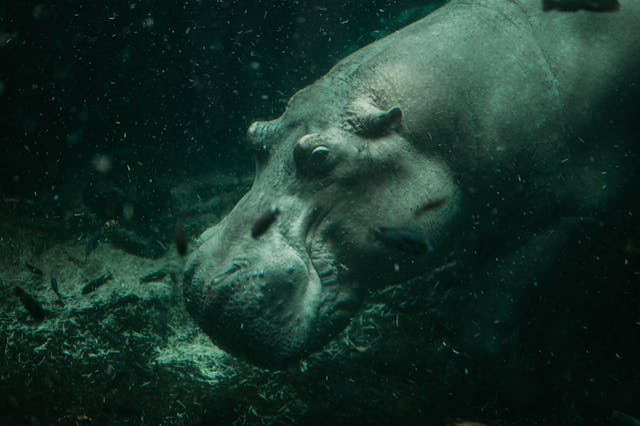
How can hippos sleep underwater? They have a reflex that makes them bob up and down in the water while they are asleep so that they can breathe.
Hippos are the third largest land animals. They are only beaten by white rhinos and elephants. Hippos grow up to 5 m long, including their tails, and they can weigh up to about 1.5 tons. They are herbivores, but they are notoriously aggressive and there are far more deaths and injuries caused by hippos every year than by any other animals. It is estimated that they kill about 500 people a year. They can run at 30 km/h over a short distance and they have sharp tusks that can grow up to 40 cm long. They use these tusks primarily for fighting. They are so big, powerful, and aggressive that they don’t really have any predators. Young and old hippos are sometimes eaten by crocodiles or lions, but it would take a whole pride of lions to take down an adult hippo, and that expenditure of energy is just not worth it for the lion.
Hippos spend a lot of their time in water because the water keeps them cool and helps take some of their weight. Hippos are also used to being in water because their closest relative, evolutionarily, is the whale and the dolphin. Whales and hippos diverged about 55 million years ago. They may have had a long time to evolve, but whales and hippos still share some similarities and some of these similarities help hippos spend so long in water. Whales and hippos both have a similar type of stomach. They both have single-lobed lungs, which can be filled with air far more quickly than our lungs. They both have a thick layer of fat or blubber. They both have very dense bones. Whales need dense bones to be able to dive rapidly into the ocean. They both have no hair and no sweat glands, which ocean going animals don’t need, but which hippos would probably be grateful for. Hippos also have webbed feet. Both hippos and whales have ears adapted to being able to hear underwater and larynxes that are very large. Whales use their larynx to produce whale song and hippos use it to make the incredibly loud and powerful “wheeze honk” that they are known for. Hippos can be heard up to 1 km away.
Hippos spend about 16 hours of every day in water. They have very thick skin, but it is sensitive and they try to keep out of the sun as much as possible. While they are on land, they secrete a red oil that moistens their skin and protects them from the sun. This oil has microscopic structures in it that scatter sunlight, protecting the hippo’s skin. However, they do dry out and burn, so they like to be in the water as much as possible. They tend to stay in the water all day and come out at dusk to eat. They have to eat about 50 kg of grass, leaves, and plants a day.
When they are in the water, they naturally sink to the bottom because of the dense bones they share with whales. Once there, they cannot swim, so they kind of walk-bounce along the bottom. Their eyes, nostrils, and ears are on the top of their heads, so they can breathe and see so long as the water is not deeper than they are tall. When they go deeper, their ears and nostrils seal up to keep the water out. They can hold their breath for about five minutes, which is longer than us, but not a very long length of time. Some whales and seals can hold their breath for over two hours. Hippos don’t need to hold their breath for longer than five minutes because they don’t go very deep and are never that far from the surface. It can take a whale several minutes to get to the surface from deep in the ocean.
So, how do hippos sleep underwater? They spend 16 hours of each day in the water and they nap a lot during that time. If the water is shallow enough, they keep their nostrils out of the water and breathe normally. If the water is deeper, they stand on the bottom of the lake or river and the buoyancy keeps them upright. They sleep, but every few minutes a subconscious reflex makes them kick off the bottom and float to the surface. They breathe out, take in a big lungful of air, and sink back down again, all without waking up. Their single-lobed lungs help them take in a large quantity of air very quickly, so they don’t need to stay on the surface for long. This is how they can sleep underwater. And this is what I learned today.
Photo by David Guerrero: https://www.pexels.com/photo/a-hippopotamus-underwater-13252415/
Sources
https://www.livescience.com/27339-hippos.html
https://animals.sandiegozoo.org/animals/hippo
https://www.nationalgeographic.com/animals/mammals/facts/hippopotamus
https://en.wikipedia.org/wiki/Hippopotamus
https://www.nbcnews.com/id/wbna29727352
https://en.wikipedia.org/wiki/Whippomorpha
https://www.discoverwildlife.com/animal-facts/can-hippos-breathe-underwater
